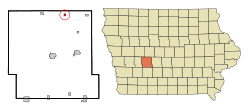Bagley, Iowa
| Bagley, Iowa | |
|---|---|
| City | |
 Location of Bagley, Iowa |
|
| Coordinates: 41°50′48″N 94°25′44″W / 41.84667°N 94.42889°WCoordinates: 41°50′48″N 94°25′44″W / 41.84667°N 94.42889°W | |
| Country |
|
| State |
|
| County | Guthrie |
| Incorporated | June 12, 1950 |
| Area | |
| • Total | 0.31 sq mi (0.80 km2) |
| • Land | 0.31 sq mi (0.80 km2) |
| • Water | 0 sq mi (0 km2) |
| Elevation | 1,109 ft (338 m) |
| Population (2010) | |
| • Total | 303 |
| • Estimate (2012) | 295 |
| • Density | 977.4/sq mi (377.4/km2) |
| Time zone | Central (CST) (UTC-6) |
| • Summer (DST) | CDT (UTC-5) |
| ZIP code | 50026 |
| Area code(s) | 641 |
| FIPS code | 19-04240 |
| GNIS feature ID | 0454316 |
Bagley is a city in Guthrie County, Iowa, United States. The population was 303 in the 2010 census, a decline from 354 in 2000 census. It is part of the Des Moines–West Des Moines Metropolitan Statistical Area.
Bagley had its start in the year 1881 by the building of the Chicago, Milwaukee & St. Paul railroad through that territory.
Bagley is located at 41°50′48″N 94°25′44″W / 41.84667°N 94.42889°W (41.846675, −94.428814).
According to the United States Census Bureau, the city has a total area of 0.31 square miles (0.80 km2), all of it land.
As of the census of 2010, there were 303 people, 123 households, and 81 families residing in the city. The population density was 977.4 inhabitants per square mile (377.4/km2). There were 147 housing units at an average density of 474.2 per square mile (183.1/km2). The racial makeup of the city was 93.4% White, 1.7% Native American, 0.3% Asian, 2.3% from other races, and 2.3% from two or more races. Hispanic or Latino of any race were 7.3% of the population.
...
Wikipedia
